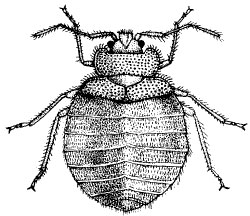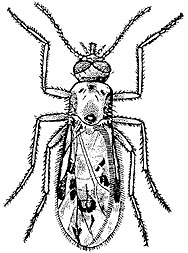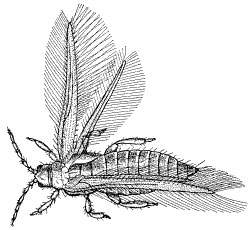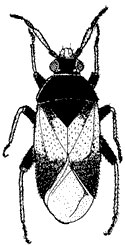There are several species of insects and mites that bite human occasionally. Some are encountered indoors while others are found outdoors. Some are specific pests of humans, with no other hosts, while others attack humans incidentally. These insects and mites vary in their biology, behavior and methods of control.
Indoor
Bed bugs and their relatives
 Figure 1
Figure 1
Bed bug (actual size 6 to 9 millimeters).
The common bed bug, Cimex lectularius, belongs to the family Cimicidae (Figure 1). A related species called the tropical bed bug, Cimex hemipterus, occurs in the southern United States but is relatively uncommon in Missouri. Bed bugs are brown, flattened, oval, wingless and 6 to 9 millimeters long when unfed. They possess a piercing-sucking beak through which they imbibe the blood of a host. When engorged with blood, the body becomes swollen and elongated, and the color changes to a dull red. Newly hatched bugs are the same shape as adults but translucent and nearly colorless.
Bed bugs hide in cracks and crevices in and around the bed during the day and come out at night to feed on people asleep in the bed. The result of their bite is an itchy, inflamed wheal, or slightly elevated area of skin, at the site of beak insertion. Bed bugs are not known to carry diseases but are undesirable because of their irritating bite.
There are several other bugs in the bed bug family that may accidentally become biting pests of humans. Bats are infested with a close relative, the bat bug, Cimex adjunctus. Like the bed bug, bat bugs live away from their host except when feeding. When bats infest a structure and are later excluded, bat bugs leave the bat roosting area in search of a blood meal. If humans are nearby, they can be bitten by bat bugs. Similarly, the swallow bug, Oeiacus vicarious, and the poultry bug, Haematosiphon inodorus, can be found in homes that have birds roosting in the attic or walls. When the birds are removed, swallow bugs may crawl about and bite humans.
Control
Thoroughly clean bed coverings, mattresses and pillows. Lightly but thoroughly mist all cracks and crevices in the bed frame, springs, slats and mattress with an aerosol insecticide. Do not treat the entire surface of the mattress; focus on the creases around the edges and buttons. Treat all crevices in the infested area, especially around doors, windows, picture frames, baseboards, etc. Bat bugs or swallow bugs in the attic and wall voids can be treated by a light but thorough application of a suitable insecticide to the infested areas.
Pyrethrins and pyrethroids (usually have active ingredients ending in -thrin) that include bed bugs on the label can be used for these treatments. Do not use bedding until it is thoroughly dry. Read and follow all label directions when using these products.
Bird and rodent mites
 Figure 2
Figure 2
Chicken mite (actual size approximately 1 millimeter).
Several species of mites are blood-sucking parasites of birds and rodents. Under normal conditions they are confined to their specific hosts. Rats and mice may live in human residences and birds may nest on and in our homes. Problems occur when something happens to remove the normal host. The mites left behind become hungry for a blood meal and start to wander in search of a new host. If a human is the first warm-blooded animal encountered, the mites will bite. The result may be a mild to severe dermatitis at the site where the mites' mouthparts were inserted.
Common bird mites involved in this type of "accidental parasitism" include the chicken mite, Dermanyssus gallinae (Figure 2), the northern fowl mite, Ornithonyssus sylviarum, and the tropical fowl mite, Ornithonyssus bursa. Common rodent mites include the tropical rat mite, Ornnithonyssus bacotiand the house mouse mite, Liponyssoides sanguineus.All of these mites are less than 1 mm long and barely visible to the naked eye.
Control
Dead carcasses from rodent trapping and baiting should be removed and disposed of daily to avoid the migration of mites to humans. Birds should be denied nesting access to any part of the home. When a nest is built on the outside of the house, it should be removed as soon as it is discovered. Since these mites do not live long without their normal host or reproduce on humans, the problem will eventually be gone — even with no intervention.
Outdoor
Biting midges
 Figure 3
Figure 3
Biting midge (actual size approximately 1.5 millimeter).
Biting midges, also called punkies or no-see-ums, are tiny (about 1.5 mm long) flies of the family Ceratopogonidae (Figure 3). They have piercing-sucking mouthparts and attack almost any warm-blooded animal in search of a blood meal.
The bites of most species cause an immediate sharp pain. This is followed by the development of red areas. For most people these lesions last up to a week or more and are more painful than mosquito bites.
The larval stage of biting midges is wormlike and develops in standing water, wet soil, or wet organic matter. It takes about a month to complete development from egg to adult. Because of the aquatic or semiaquatic habitat of the larvae, adults are more likely to be a biting problem in areas near wet environments. Most biting activity takes place at twilight. Only the female midge is a blood feeder; the male feeds on plant juices.
Control
Effective control is difficult. Whenever possible, eliminate the wet conditions of the larval habitat. Area fogging and spraying offers little control and only brief relief. The best protection is the use of an insect repellent containing the active ingredient diethyl toluamide (DEET).
Thrips
 Figure 4
Figure 4
Thrips (actual size 1.5 to 3 millimeters long).
Thrips are small (1.5 to 3 mm long) plant-feeding insects of the order Thysanoptera. They have raspingsucking mouthparts and normally feed on the "slush" created by rasping away the surface of a leaf. Some thrips are wingless and are not a biting threat to humans, but many others with narrow, fringed wings have the ability to fly and consequently land on humans (Figure 4).
Large numbers of thrips may be flying about when searching for a mate or when their host plant withers and they are searching for another one. If they land on the bare skin of a human, they "rasp" the skin, causing a sudden burning sensation at the bite site. They soon find that human skin is devoid of plant juices and fly away or crawl to a new site to rasp the skin again. In some people, a red wheal may develop with an itching sensation persisting for several days. Thrips do not seek humans as a food source. Their bites are only incidental.
Control
Repellents offer no protection. If you must be in an area where thrips are abundant and active, the best protection from bites is to wear a long-sleeved shirt with upturned collar and long pants. Peak thrips activity occurs during bright sunlight. Farm workers are most likely to be bitten, because they are most likely to be around the host plants.
Minute pirate bugs

Figure 5
Insidious flower bug (actual size 2 to 4 millimeters).
Minute pirate bugs are small (2 to 4 mm) predaceous bugs of the family Anthocoridae. They normally feed on other small insects, mites or insect eggs by sucking the body fluids of their prey If they land on human skin, they may decide to bite. The result is a sudden painful sensation. Pirate bugs may continue biting for several seconds unless they are wiped away. This results in an itching, red wheal that can persist for several days.
The most common species that bites humans is the insidious flower bug, Orius insidiosus (Figure 5). It has a black body with contrasting, clear white wing tips, which lie flat on the top of the body when at rest.
Control
Since their biting of humans is incidental, keeping the skin covered with clothing is the best way to avoid their bites.
Warning on the use of chemicals
Apply chemicals only where needed or justified. Before using any chemical, please read the label carefully for directions on application procedures, appropriate rate, first aid, storage and disposal. Make sure that the chemical is properly registered for use on the intended pest and follow all other label directions. Keep insecticides in original containers, complete with labels, and keep them out of the reach of children and pets. Do not allow children or pets near treated areas before these areas dry. Carefully and properly dispose of unused portions of diluted sprays and empty insecticide containers.